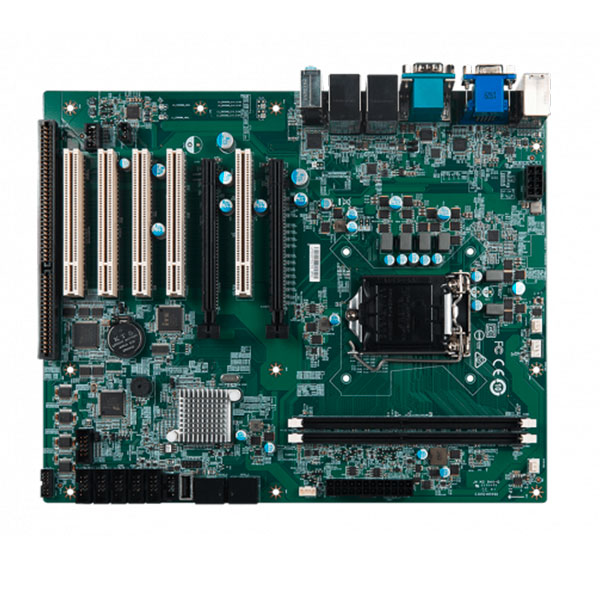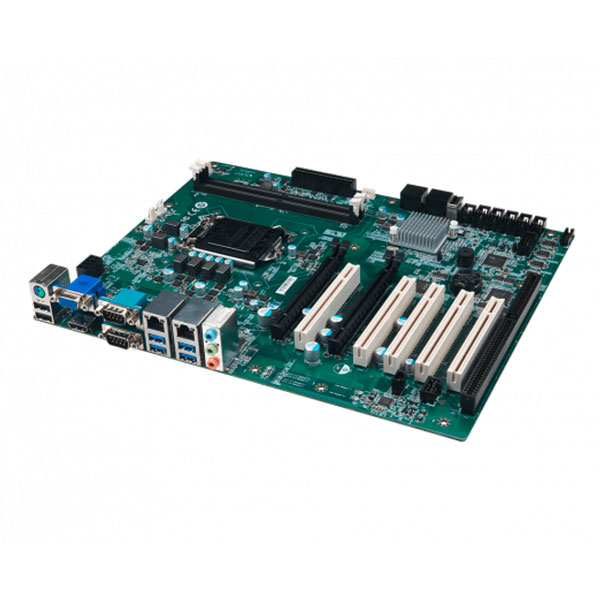MSI's LGA1151 Motherboard Takes Us Back to 1992 With PCI Slots

EDIT, 15/03/2020, 3:00pm PT: MSI is the manufacturer behind the MS-98L9 V2.0. German retailer Spectra is one of the few to list the motherboard on its website. We have amended the text below to accurately reflect the situation:
As discovered by German publication HardwareLuxx, MSI has created a rather peculiar LGA1151-based motherboard for consumers that are still using archaic hardware. The MS-98L9 V2.0 apparently resurrects the defunct PCI interface, among other fascinating relics.
Maintaining the old-time look, the MS-98L9 V2.0 comes with a green PCB that adheres to the standard ATX form factor. The motherboard has a LGA1151 socket, and it's based on the Intel H110 chipset. This means that it can accommodate Intel processors up to the 7th Generation Kaby Lake chips that have enjoyed retirement since October 2019. Don't let the feeble power delivery subsystem fool you, though. MSI states the MS-98L9 V2.0 can handle Kaby Lake parts up to 95W without a sweat.
The MS-98L9 V2.0 comes with two DDR4 memory slots and supports dual-channel memory kits up to DDR4-2400 for a maximum capacity of 32GB. The motherboard only has four SATA III ports, but lacks an M.2 port, meaning you're out of luck when it comes to high-speed solid-state storage options unless you use one of the PCIe slots.

The MS-98L9 V2.0's expansion configuration is one of the more interesting parts of the motherboard. It has one conventional PCIe x16 slot, one PCIe x16 slot wired at x4 and five vintage white PCI slots. At this point, we're suprised that MSI didn't throw an AGP slot into the mix as well. However, the motherboard manufacturer does include an ISA (Industry Standard Architecture) slot that dates way back to the 1980's.
The list of internal headers on the MS-98L9 V2.0 includes two USB 2.0 headers, one GPIO (general-purpose input/output) header, four COM headers, one SMBus (System Management Bus) header and one TPM (Trusted Platform Module) header. The motherboard depends on the Realtek ALC887-VD2-CG codec for audio and the Fintek F81866AD-I controller for I/O.
The MS-98L9 V2.0 can support up to two displays. The VGA port handles resolutions up to 1920 x 1200 at 60Hz and the HDMI port can output resolutions up to 4096 x 2160 at 24Hz. The motherboard provides two Gigabit Ethernet ports. One is based on Intel's I219-LM controller while the other is based relies on the I211-AT controller.
Get Tom's Hardware's best news and in-depth reviews, straight to your inbox.
In addition to the aforementioned interfaces, the motherboard's rear panel also holds two USB 2.0 ports, one PS/2 combo port, two COM ports, four USB 3.0 ports and three 3.5mm audio jacks.
Spectra doesn't list a price for the MS-98L9 V2.0. If you're interested in the motherboard, you'll have to request a quote directly from the company.

Zhiye Liu is a news editor, memory reviewer, and SSD tester at Tom’s Hardware. Although he loves everything that’s hardware, he has a soft spot for CPUs, GPUs, and RAM.
-
bit_user This article is just ignorant. Boards like these are nothing new. PCI is apparently still used in a variety of industrial scenarios, and I count about 60 SKUs, over on ark.intel.com, from Skylake and Kaby Lake generations that have a FCLGA1151 socket and are not discontinued.Reply
When Intel discontinues processors in a certain family, it doesn't discontinue all models of them. Some will continue to be available for use in products (e.g. such as industrial equipment) for an extended period of time, so that its OEM customers don't have to update and retest their designs every couple years, which could be cost-prohibitive for them. -
TechLurker This would be pretty neat for some actual old-school builds with a touch of modern tech to it. A shame they didn't include an AGP slot though.Reply
It does remind me of those bizarre Chinese mobos that also recycle old hardware elements that Linus and others have reviewed in the past. I recall some builders were also using similar such boards to revive old Windows rigs that ran 95, 98, 2000, and XP, just with slightly newer internal elements (like running DDR3 instead of DDR2 or DDR1). Moreso since most newer processors and mobos don't officially support legacy software. -
froggx I found a PCI 100base-tx ethernet card in a dusty cardboard box labelled "Do not burn indoors!" for a project earlier this week, enthusiastically plugged it into the sole PCI slot on my Sandy Bridge mobo, and actually said "hardcore old school!" out loud. Then I read this article and I suddenly feel very small, much like when looking at a starry night while thinking too hard.Reply
I love how I learned Total Productive Maintenance in my process management class. Which was in business school... We weren't even allowed to use calculators in that course so I loved that little typo they made up there xDPinhedd said:TPM = Trusted Platform Module... -
KesZerda Pretty much everything in this article is wrong, and/or lazily researched. Spectra's a reseller/integrator for industrial equipment, and this board wasn't made by them, it was made by MSI, and is part of their industrial lineup ( https://ipc.msi.com/products_list/Industrial-Motherboard ). There are quite a few industrial machines which use older i/o interfaces, where the cost of replacing existing interface cards, including PCB design, certifying functionality, etc, are prohibitively expensive. So, companies like MSI build these low-run motherboards for the purpose of being as drop-in as possible. These aren't for weird retro gaming stuff, these are for big beefy cnc machines which use serial ports and isa cards to talk to the controller software.Reply -
alextheblue Reply
EXACTLY! I read the headline and was like wait, what? It's just another industrial-focused board. But then I looked at the picture of the board and I thought "Wait, is that a @*%$ing ISA SLOT??"ravewulf said:The PCI slots don't surprise me but the ISA slot certainly did
I can't recall having an ISA slot since my 486. -
taz-nz Replyalextheblue said:I can't recall having an ISA slot since my 486.
They were around until the end of the Pentium 4.
They were perfect for ISA Hardware 56k modems, all PCI slot 56k modem were WinTel software modems. -
escksu Legacy slots/ports are nothing new. There are many industrial equipment that relies on them. Unlike PCs, industrial equipment could cost hundreds of thousands to millions. So they are not replaced often, many are in user for over 20yrs. Some older ones are still using floppy disks.Reply
Not just slots/ports. Even OS too. Some software used for these equipment will only work on Windows 7 or older OS. No windows 10. Even older ones are still on MSDOS!! -
escksu Replyalextheblue said:EXACTLY! I read the headline and was like wait, what? It's just another industrial-focused board. But then I looked at the picture of the board and I thought "Wait, is that a @*%$ing ISA SLOT??"
I can't recall having an ISA slot since my 486.
You sure?? PCI don't even exist till pentium days. Prior to PCI, all PCs are using VESA and ISA (EISA is rare).